Managerial Accounting System Analysis Report for HI5017, T2 2019
VerifiedAdded on 2022/11/29
|17
|4277
|211
Report
AI Summary
This report provides a comprehensive analysis of Managerial Accounting Systems (MAS), exploring its techniques and applications in contemporary business contexts. The study examines two journal articles to evaluate the practical use of MAS by companies, focusing on its relevance in decision-making processes. The report delves into various MAS techniques such as Just in Time (JIT), Total Quality Management (TQM), and Activity-Based Costing (ABC), assessing their impact on operational, tactical, and strategic decision-making levels within organizations. The analysis highlights the benefits of MAS in improving cost allocation, enhancing efficiency, and supporting business growth, while also acknowledging the diverse ways in which different levels of management utilize these systems. The report also includes a comparison of the two articles to identify similar outcomes and provide insights into the practical implementation of MAS in real-world scenarios. Overall, the report emphasizes the importance of MAS in aiding managers in making informed decisions and achieving business goals.
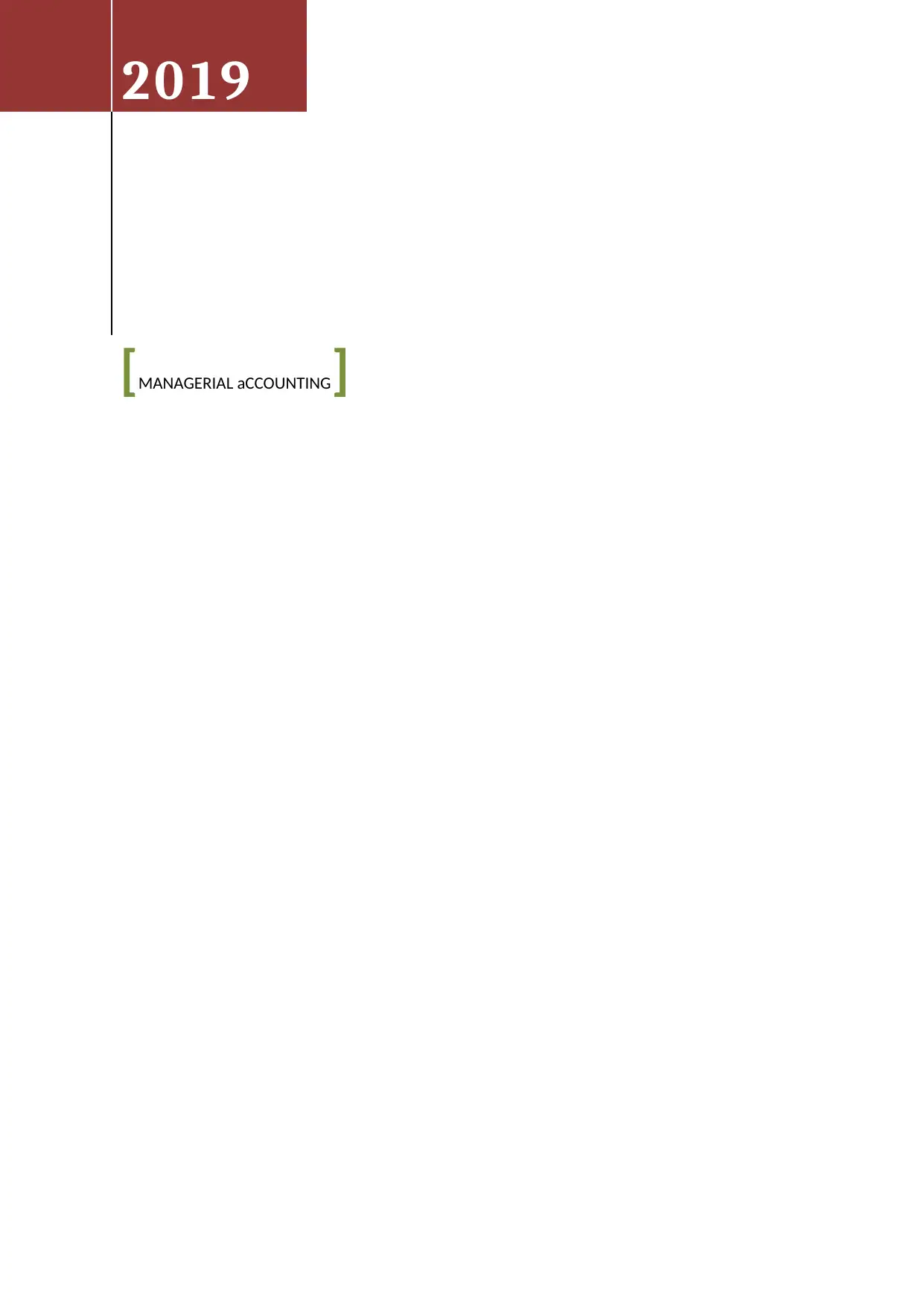
[MANAGERIAL aCCOUNTING]
2019
2019
Paraphrase This Document
Need a fresh take? Get an instant paraphrase of this document with our AI Paraphraser
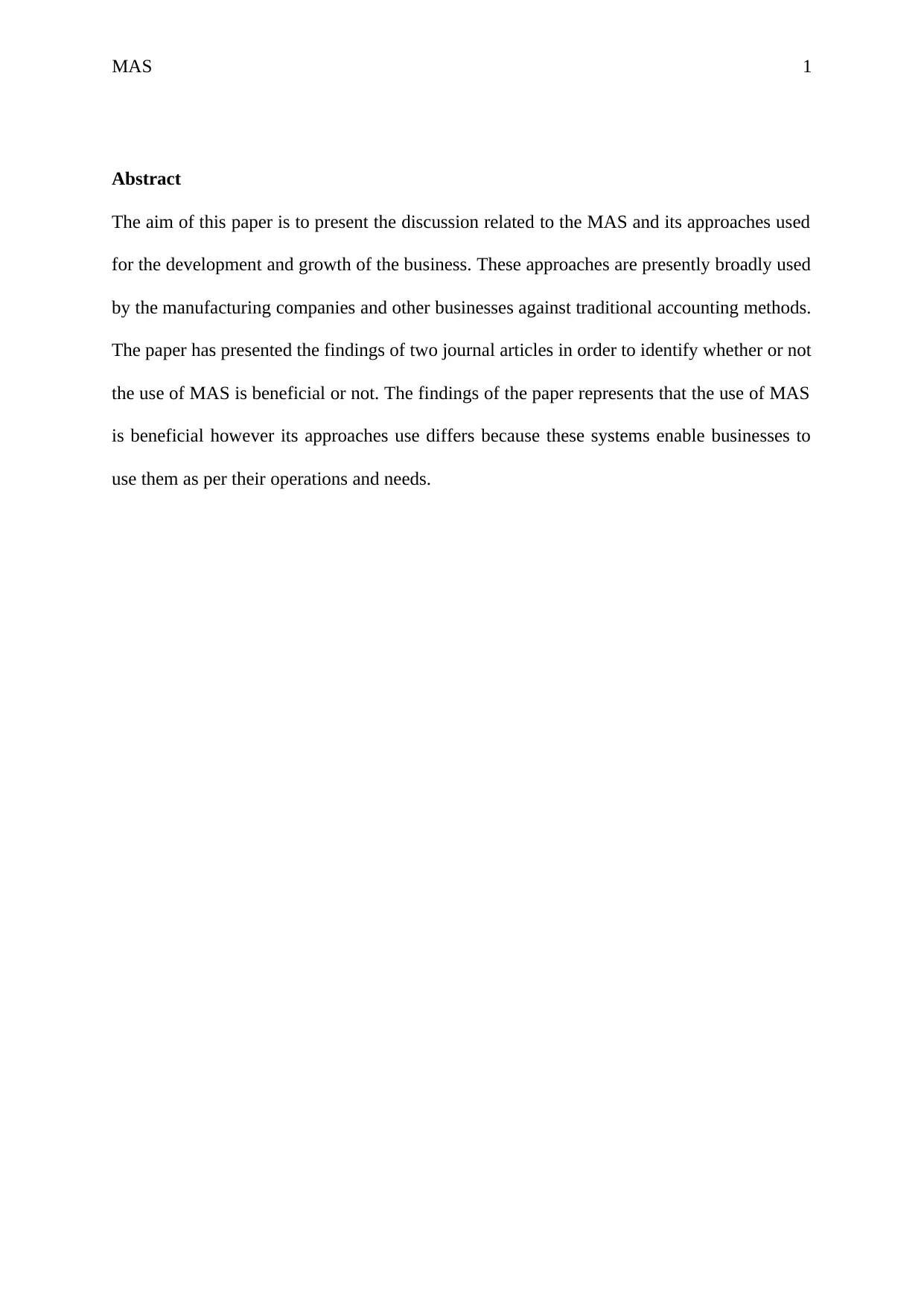
MAS 1
Abstract
The aim of this paper is to present the discussion related to the MAS and its approaches used
for the development and growth of the business. These approaches are presently broadly used
by the manufacturing companies and other businesses against traditional accounting methods.
The paper has presented the findings of two journal articles in order to identify whether or not
the use of MAS is beneficial or not. The findings of the paper represents that the use of MAS
is beneficial however its approaches use differs because these systems enable businesses to
use them as per their operations and needs.
Abstract
The aim of this paper is to present the discussion related to the MAS and its approaches used
for the development and growth of the business. These approaches are presently broadly used
by the manufacturing companies and other businesses against traditional accounting methods.
The paper has presented the findings of two journal articles in order to identify whether or not
the use of MAS is beneficial or not. The findings of the paper represents that the use of MAS
is beneficial however its approaches use differs because these systems enable businesses to
use them as per their operations and needs.
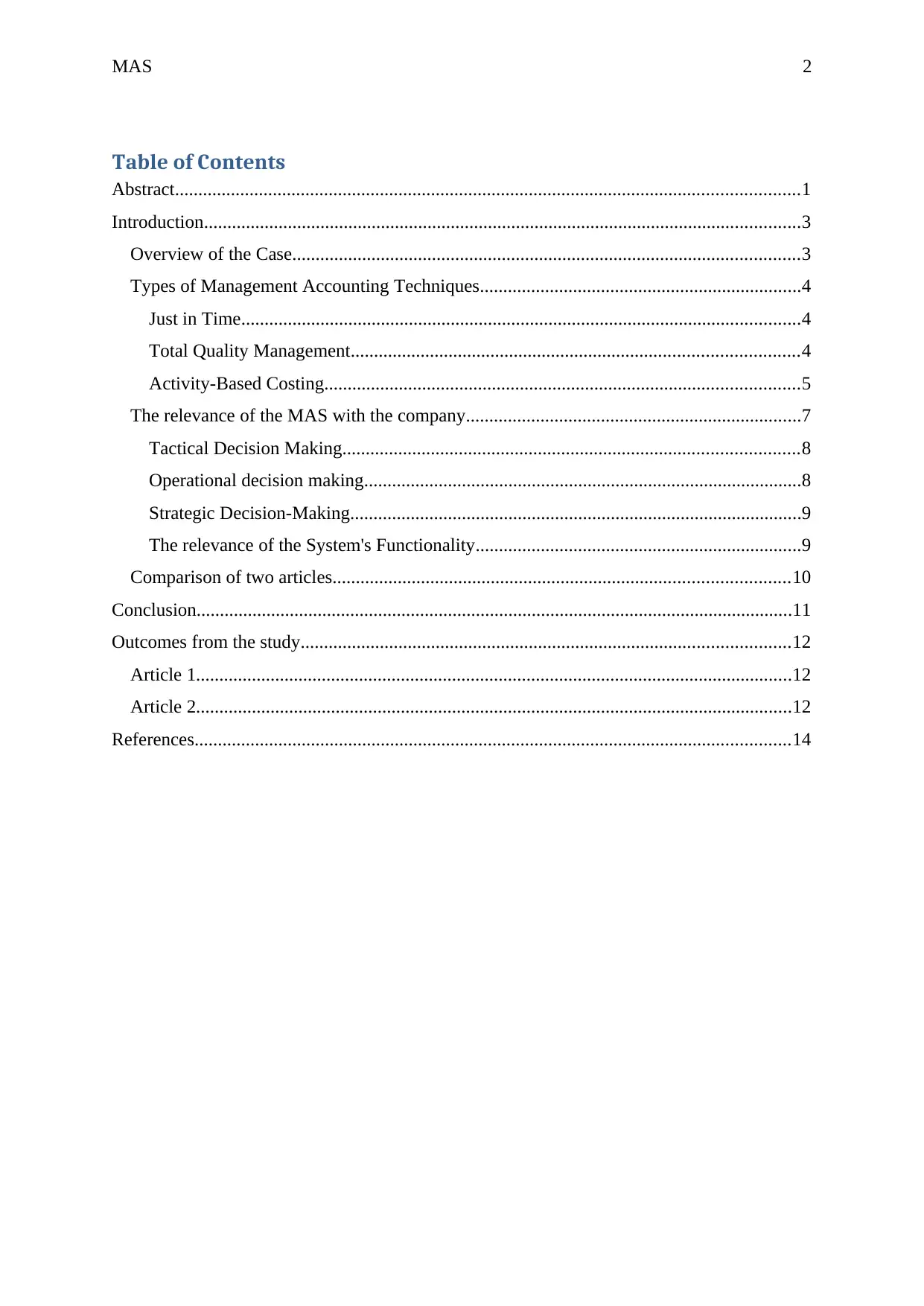
MAS 2
Table of Contents
Abstract......................................................................................................................................1
Introduction................................................................................................................................3
Overview of the Case.............................................................................................................3
Types of Management Accounting Techniques.....................................................................4
Just in Time........................................................................................................................4
Total Quality Management................................................................................................4
Activity-Based Costing......................................................................................................5
The relevance of the MAS with the company........................................................................7
Tactical Decision Making..................................................................................................8
Operational decision making..............................................................................................8
Strategic Decision-Making.................................................................................................9
The relevance of the System's Functionality......................................................................9
Comparison of two articles..................................................................................................10
Conclusion................................................................................................................................11
Outcomes from the study.........................................................................................................12
Article 1................................................................................................................................12
Article 2................................................................................................................................12
References................................................................................................................................14
Table of Contents
Abstract......................................................................................................................................1
Introduction................................................................................................................................3
Overview of the Case.............................................................................................................3
Types of Management Accounting Techniques.....................................................................4
Just in Time........................................................................................................................4
Total Quality Management................................................................................................4
Activity-Based Costing......................................................................................................5
The relevance of the MAS with the company........................................................................7
Tactical Decision Making..................................................................................................8
Operational decision making..............................................................................................8
Strategic Decision-Making.................................................................................................9
The relevance of the System's Functionality......................................................................9
Comparison of two articles..................................................................................................10
Conclusion................................................................................................................................11
Outcomes from the study.........................................................................................................12
Article 1................................................................................................................................12
Article 2................................................................................................................................12
References................................................................................................................................14
⊘ This is a preview!⊘
Do you want full access?
Subscribe today to unlock all pages.

Trusted by 1+ million students worldwide
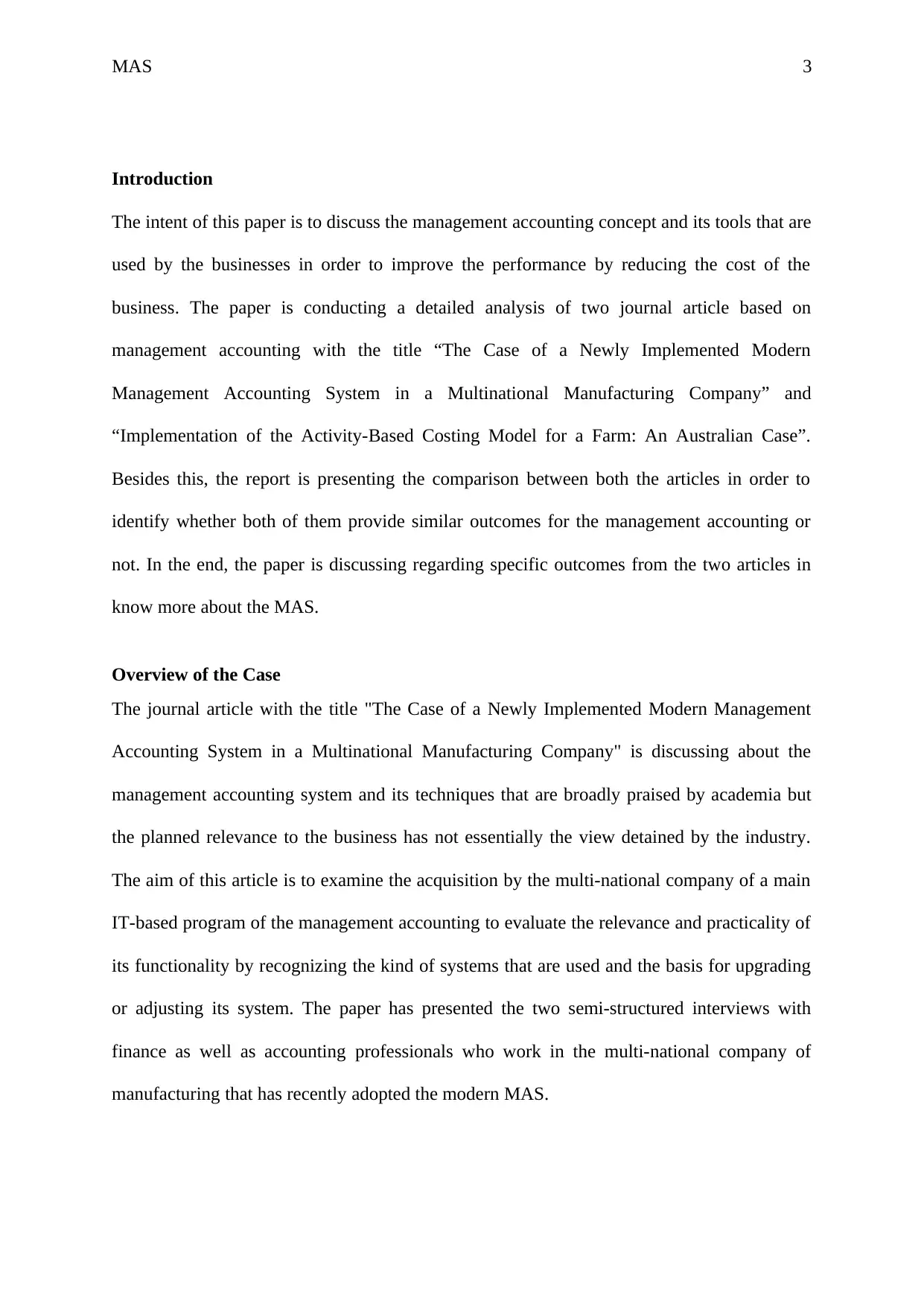
MAS 3
Introduction
The intent of this paper is to discuss the management accounting concept and its tools that are
used by the businesses in order to improve the performance by reducing the cost of the
business. The paper is conducting a detailed analysis of two journal article based on
management accounting with the title “The Case of a Newly Implemented Modern
Management Accounting System in a Multinational Manufacturing Company” and
“Implementation of the Activity-Based Costing Model for a Farm: An Australian Case”.
Besides this, the report is presenting the comparison between both the articles in order to
identify whether both of them provide similar outcomes for the management accounting or
not. In the end, the paper is discussing regarding specific outcomes from the two articles in
know more about the MAS.
Overview of the Case
The journal article with the title "The Case of a Newly Implemented Modern Management
Accounting System in a Multinational Manufacturing Company" is discussing about the
management accounting system and its techniques that are broadly praised by academia but
the planned relevance to the business has not essentially the view detained by the industry.
The aim of this article is to examine the acquisition by the multi-national company of a main
IT-based program of the management accounting to evaluate the relevance and practicality of
its functionality by recognizing the kind of systems that are used and the basis for upgrading
or adjusting its system. The paper has presented the two semi-structured interviews with
finance as well as accounting professionals who work in the multi-national company of
manufacturing that has recently adopted the modern MAS.
Introduction
The intent of this paper is to discuss the management accounting concept and its tools that are
used by the businesses in order to improve the performance by reducing the cost of the
business. The paper is conducting a detailed analysis of two journal article based on
management accounting with the title “The Case of a Newly Implemented Modern
Management Accounting System in a Multinational Manufacturing Company” and
“Implementation of the Activity-Based Costing Model for a Farm: An Australian Case”.
Besides this, the report is presenting the comparison between both the articles in order to
identify whether both of them provide similar outcomes for the management accounting or
not. In the end, the paper is discussing regarding specific outcomes from the two articles in
know more about the MAS.
Overview of the Case
The journal article with the title "The Case of a Newly Implemented Modern Management
Accounting System in a Multinational Manufacturing Company" is discussing about the
management accounting system and its techniques that are broadly praised by academia but
the planned relevance to the business has not essentially the view detained by the industry.
The aim of this article is to examine the acquisition by the multi-national company of a main
IT-based program of the management accounting to evaluate the relevance and practicality of
its functionality by recognizing the kind of systems that are used and the basis for upgrading
or adjusting its system. The paper has presented the two semi-structured interviews with
finance as well as accounting professionals who work in the multi-national company of
manufacturing that has recently adopted the modern MAS.
Paraphrase This Document
Need a fresh take? Get an instant paraphrase of this document with our AI Paraphraser
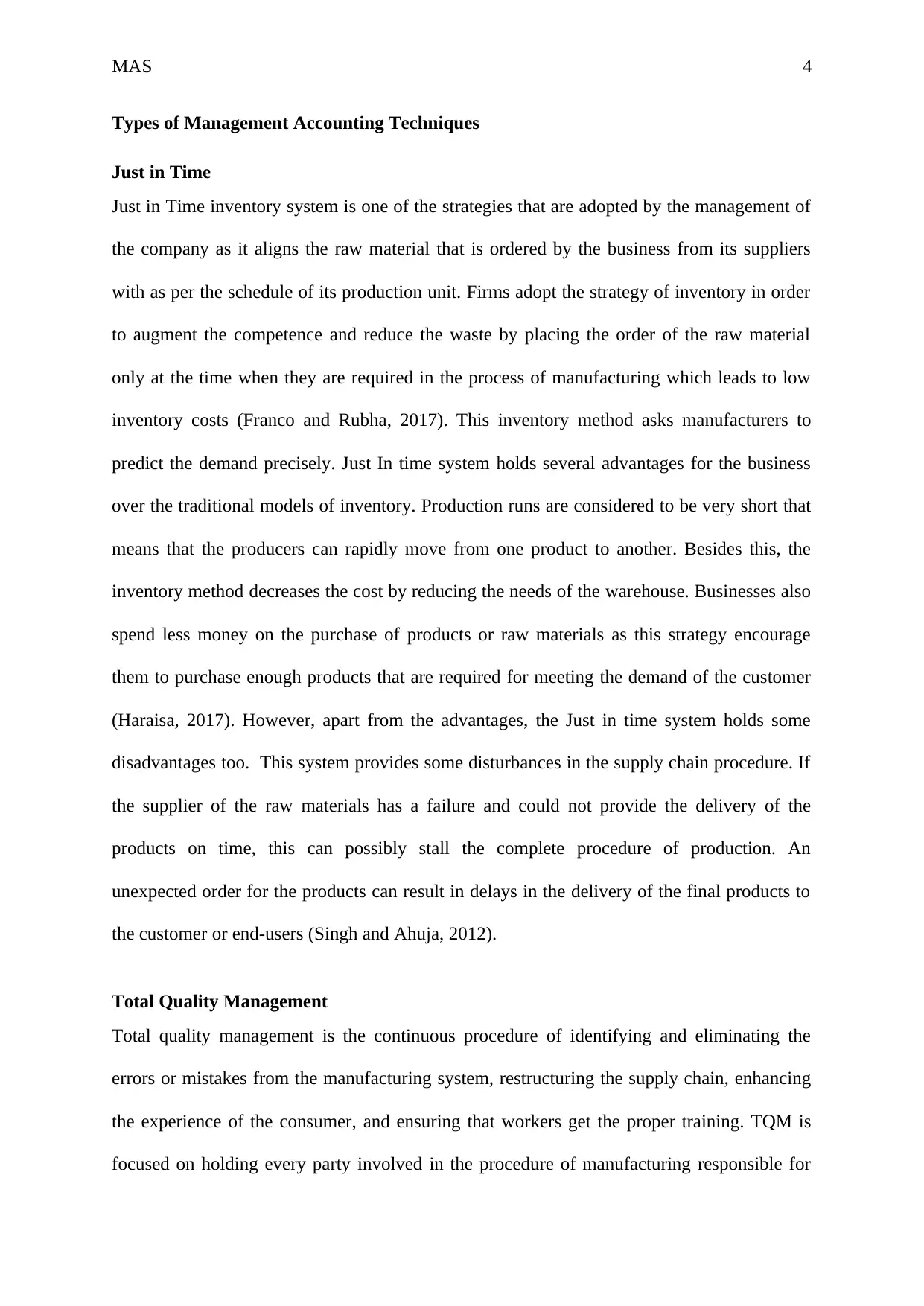
MAS 4
Types of Management Accounting Techniques
Just in Time
Just in Time inventory system is one of the strategies that are adopted by the management of
the company as it aligns the raw material that is ordered by the business from its suppliers
with as per the schedule of its production unit. Firms adopt the strategy of inventory in order
to augment the competence and reduce the waste by placing the order of the raw material
only at the time when they are required in the process of manufacturing which leads to low
inventory costs (Franco and Rubha, 2017). This inventory method asks manufacturers to
predict the demand precisely. Just In time system holds several advantages for the business
over the traditional models of inventory. Production runs are considered to be very short that
means that the producers can rapidly move from one product to another. Besides this, the
inventory method decreases the cost by reducing the needs of the warehouse. Businesses also
spend less money on the purchase of products or raw materials as this strategy encourage
them to purchase enough products that are required for meeting the demand of the customer
(Haraisa, 2017). However, apart from the advantages, the Just in time system holds some
disadvantages too. This system provides some disturbances in the supply chain procedure. If
the supplier of the raw materials has a failure and could not provide the delivery of the
products on time, this can possibly stall the complete procedure of production. An
unexpected order for the products can result in delays in the delivery of the final products to
the customer or end-users (Singh and Ahuja, 2012).
Total Quality Management
Total quality management is the continuous procedure of identifying and eliminating the
errors or mistakes from the manufacturing system, restructuring the supply chain, enhancing
the experience of the consumer, and ensuring that workers get the proper training. TQM is
focused on holding every party involved in the procedure of manufacturing responsible for
Types of Management Accounting Techniques
Just in Time
Just in Time inventory system is one of the strategies that are adopted by the management of
the company as it aligns the raw material that is ordered by the business from its suppliers
with as per the schedule of its production unit. Firms adopt the strategy of inventory in order
to augment the competence and reduce the waste by placing the order of the raw material
only at the time when they are required in the process of manufacturing which leads to low
inventory costs (Franco and Rubha, 2017). This inventory method asks manufacturers to
predict the demand precisely. Just In time system holds several advantages for the business
over the traditional models of inventory. Production runs are considered to be very short that
means that the producers can rapidly move from one product to another. Besides this, the
inventory method decreases the cost by reducing the needs of the warehouse. Businesses also
spend less money on the purchase of products or raw materials as this strategy encourage
them to purchase enough products that are required for meeting the demand of the customer
(Haraisa, 2017). However, apart from the advantages, the Just in time system holds some
disadvantages too. This system provides some disturbances in the supply chain procedure. If
the supplier of the raw materials has a failure and could not provide the delivery of the
products on time, this can possibly stall the complete procedure of production. An
unexpected order for the products can result in delays in the delivery of the final products to
the customer or end-users (Singh and Ahuja, 2012).
Total Quality Management
Total quality management is the continuous procedure of identifying and eliminating the
errors or mistakes from the manufacturing system, restructuring the supply chain, enhancing
the experience of the consumer, and ensuring that workers get the proper training. TQM is
focused on holding every party involved in the procedure of manufacturing responsible for
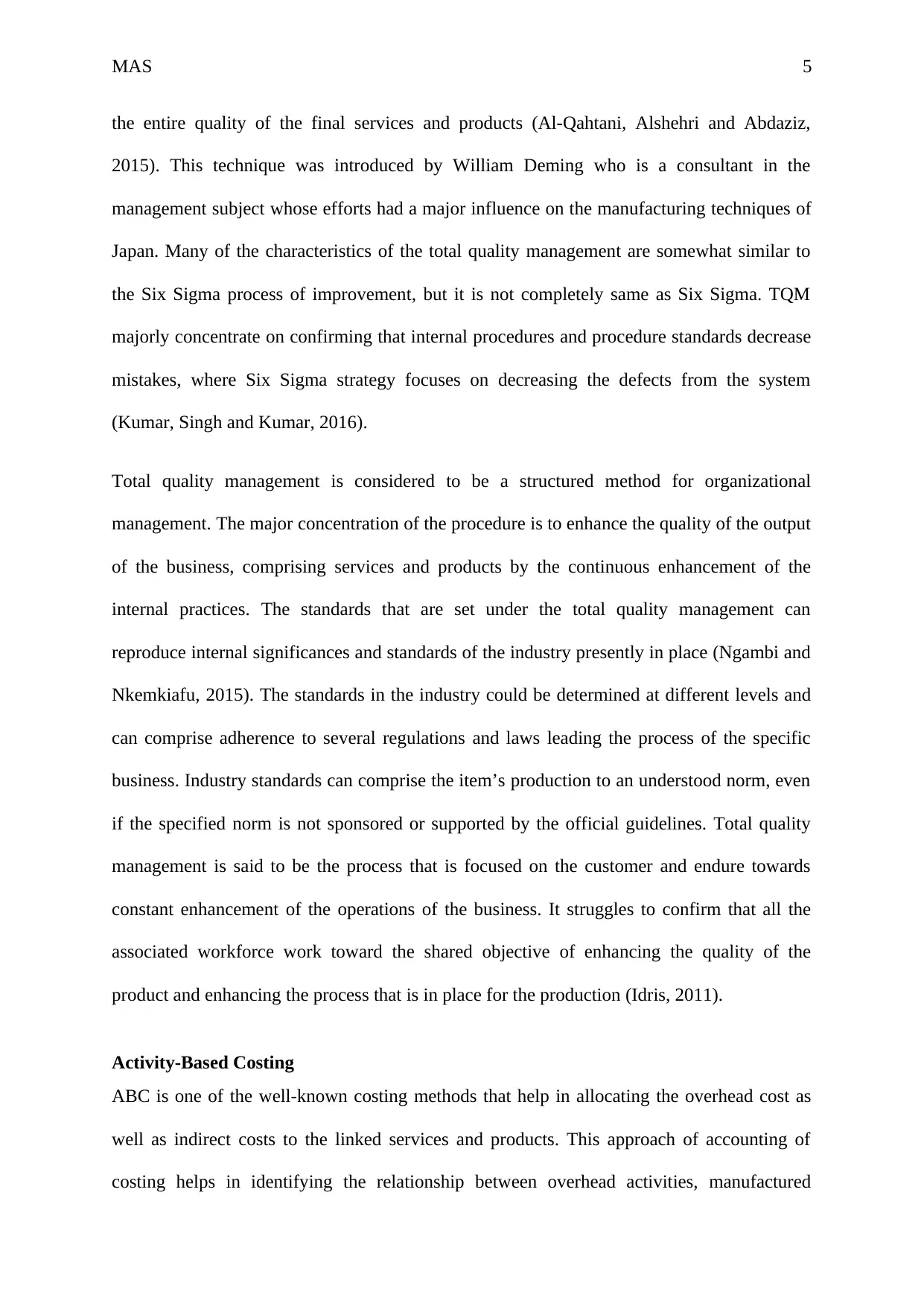
MAS 5
the entire quality of the final services and products (Al-Qahtani, Alshehri and Abdaziz,
2015). This technique was introduced by William Deming who is a consultant in the
management subject whose efforts had a major influence on the manufacturing techniques of
Japan. Many of the characteristics of the total quality management are somewhat similar to
the Six Sigma process of improvement, but it is not completely same as Six Sigma. TQM
majorly concentrate on confirming that internal procedures and procedure standards decrease
mistakes, where Six Sigma strategy focuses on decreasing the defects from the system
(Kumar, Singh and Kumar, 2016).
Total quality management is considered to be a structured method for organizational
management. The major concentration of the procedure is to enhance the quality of the output
of the business, comprising services and products by the continuous enhancement of the
internal practices. The standards that are set under the total quality management can
reproduce internal significances and standards of the industry presently in place (Ngambi and
Nkemkiafu, 2015). The standards in the industry could be determined at different levels and
can comprise adherence to several regulations and laws leading the process of the specific
business. Industry standards can comprise the item’s production to an understood norm, even
if the specified norm is not sponsored or supported by the official guidelines. Total quality
management is said to be the process that is focused on the customer and endure towards
constant enhancement of the operations of the business. It struggles to confirm that all the
associated workforce work toward the shared objective of enhancing the quality of the
product and enhancing the process that is in place for the production (Idris, 2011).
Activity-Based Costing
ABC is one of the well-known costing methods that help in allocating the overhead cost as
well as indirect costs to the linked services and products. This approach of accounting of
costing helps in identifying the relationship between overhead activities, manufactured
the entire quality of the final services and products (Al-Qahtani, Alshehri and Abdaziz,
2015). This technique was introduced by William Deming who is a consultant in the
management subject whose efforts had a major influence on the manufacturing techniques of
Japan. Many of the characteristics of the total quality management are somewhat similar to
the Six Sigma process of improvement, but it is not completely same as Six Sigma. TQM
majorly concentrate on confirming that internal procedures and procedure standards decrease
mistakes, where Six Sigma strategy focuses on decreasing the defects from the system
(Kumar, Singh and Kumar, 2016).
Total quality management is considered to be a structured method for organizational
management. The major concentration of the procedure is to enhance the quality of the output
of the business, comprising services and products by the continuous enhancement of the
internal practices. The standards that are set under the total quality management can
reproduce internal significances and standards of the industry presently in place (Ngambi and
Nkemkiafu, 2015). The standards in the industry could be determined at different levels and
can comprise adherence to several regulations and laws leading the process of the specific
business. Industry standards can comprise the item’s production to an understood norm, even
if the specified norm is not sponsored or supported by the official guidelines. Total quality
management is said to be the process that is focused on the customer and endure towards
constant enhancement of the operations of the business. It struggles to confirm that all the
associated workforce work toward the shared objective of enhancing the quality of the
product and enhancing the process that is in place for the production (Idris, 2011).
Activity-Based Costing
ABC is one of the well-known costing methods that help in allocating the overhead cost as
well as indirect costs to the linked services and products. This approach of accounting of
costing helps in identifying the relationship between overhead activities, manufactured
⊘ This is a preview!⊘
Do you want full access?
Subscribe today to unlock all pages.

Trusted by 1+ million students worldwide
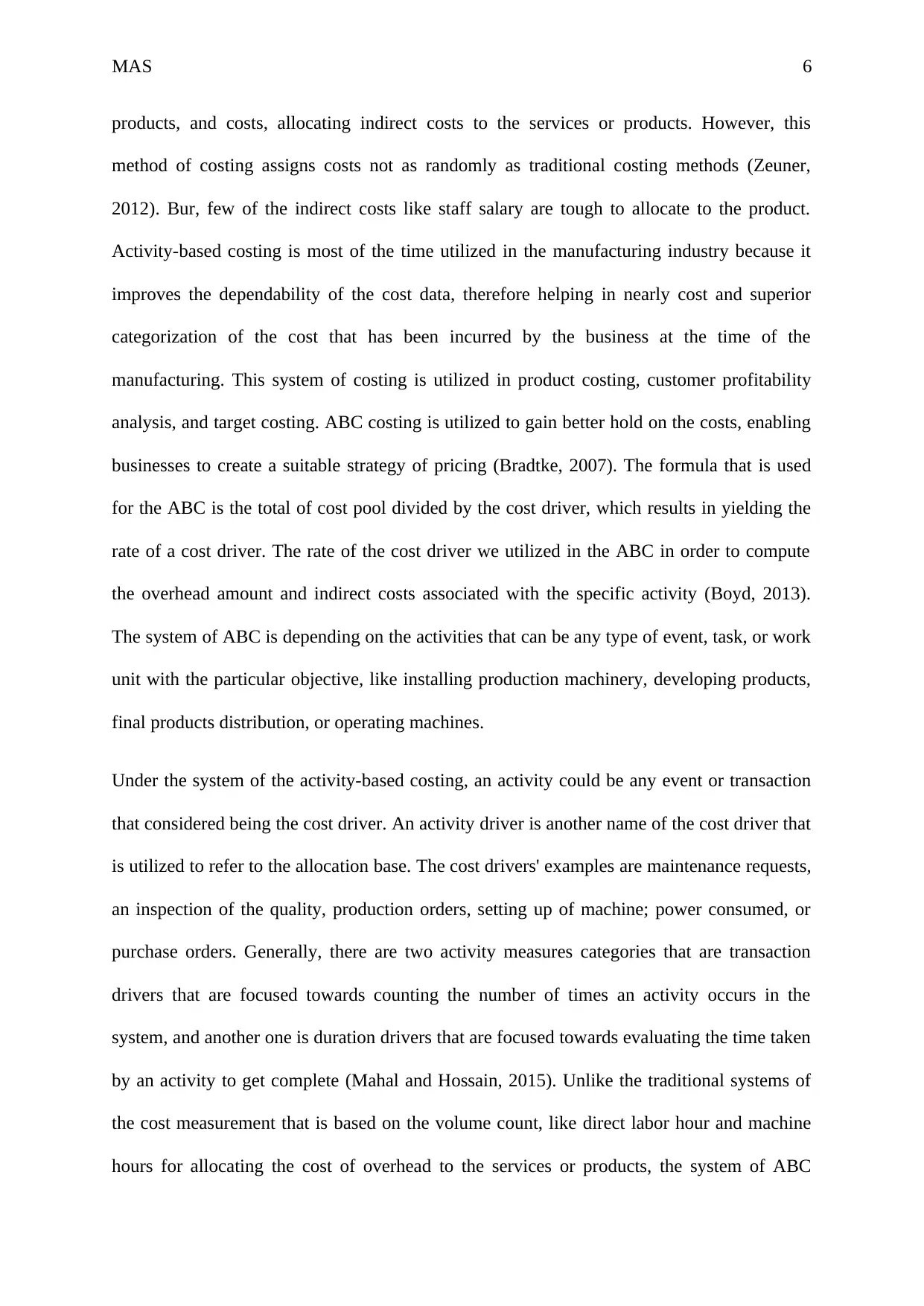
MAS 6
products, and costs, allocating indirect costs to the services or products. However, this
method of costing assigns costs not as randomly as traditional costing methods (Zeuner,
2012). Bur, few of the indirect costs like staff salary are tough to allocate to the product.
Activity-based costing is most of the time utilized in the manufacturing industry because it
improves the dependability of the cost data, therefore helping in nearly cost and superior
categorization of the cost that has been incurred by the business at the time of the
manufacturing. This system of costing is utilized in product costing, customer profitability
analysis, and target costing. ABC costing is utilized to gain better hold on the costs, enabling
businesses to create a suitable strategy of pricing (Bradtke, 2007). The formula that is used
for the ABC is the total of cost pool divided by the cost driver, which results in yielding the
rate of a cost driver. The rate of the cost driver we utilized in the ABC in order to compute
the overhead amount and indirect costs associated with the specific activity (Boyd, 2013).
The system of ABC is depending on the activities that can be any type of event, task, or work
unit with the particular objective, like installing production machinery, developing products,
final products distribution, or operating machines.
Under the system of the activity-based costing, an activity could be any event or transaction
that considered being the cost driver. An activity driver is another name of the cost driver that
is utilized to refer to the allocation base. The cost drivers' examples are maintenance requests,
an inspection of the quality, production orders, setting up of machine; power consumed, or
purchase orders. Generally, there are two activity measures categories that are transaction
drivers that are focused towards counting the number of times an activity occurs in the
system, and another one is duration drivers that are focused towards evaluating the time taken
by an activity to get complete (Mahal and Hossain, 2015). Unlike the traditional systems of
the cost measurement that is based on the volume count, like direct labor hour and machine
hours for allocating the cost of overhead to the services or products, the system of ABC
products, and costs, allocating indirect costs to the services or products. However, this
method of costing assigns costs not as randomly as traditional costing methods (Zeuner,
2012). Bur, few of the indirect costs like staff salary are tough to allocate to the product.
Activity-based costing is most of the time utilized in the manufacturing industry because it
improves the dependability of the cost data, therefore helping in nearly cost and superior
categorization of the cost that has been incurred by the business at the time of the
manufacturing. This system of costing is utilized in product costing, customer profitability
analysis, and target costing. ABC costing is utilized to gain better hold on the costs, enabling
businesses to create a suitable strategy of pricing (Bradtke, 2007). The formula that is used
for the ABC is the total of cost pool divided by the cost driver, which results in yielding the
rate of a cost driver. The rate of the cost driver we utilized in the ABC in order to compute
the overhead amount and indirect costs associated with the specific activity (Boyd, 2013).
The system of ABC is depending on the activities that can be any type of event, task, or work
unit with the particular objective, like installing production machinery, developing products,
final products distribution, or operating machines.
Under the system of the activity-based costing, an activity could be any event or transaction
that considered being the cost driver. An activity driver is another name of the cost driver that
is utilized to refer to the allocation base. The cost drivers' examples are maintenance requests,
an inspection of the quality, production orders, setting up of machine; power consumed, or
purchase orders. Generally, there are two activity measures categories that are transaction
drivers that are focused towards counting the number of times an activity occurs in the
system, and another one is duration drivers that are focused towards evaluating the time taken
by an activity to get complete (Mahal and Hossain, 2015). Unlike the traditional systems of
the cost measurement that is based on the volume count, like direct labor hour and machine
hours for allocating the cost of overhead to the services or products, the system of ABC
Paraphrase This Document
Need a fresh take? Get an instant paraphrase of this document with our AI Paraphraser
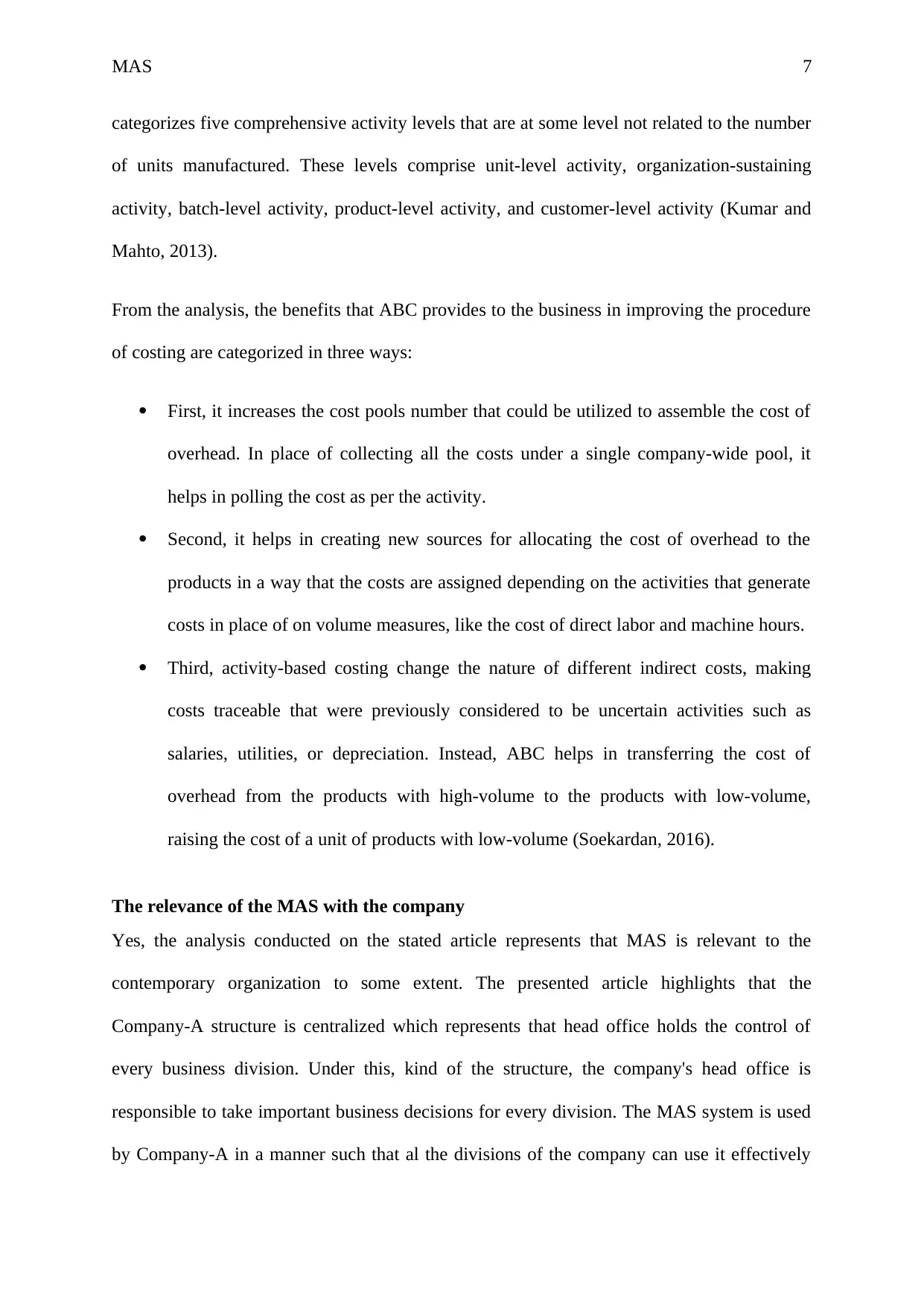
MAS 7
categorizes five comprehensive activity levels that are at some level not related to the number
of units manufactured. These levels comprise unit-level activity, organization-sustaining
activity, batch-level activity, product-level activity, and customer-level activity (Kumar and
Mahto, 2013).
From the analysis, the benefits that ABC provides to the business in improving the procedure
of costing are categorized in three ways:
First, it increases the cost pools number that could be utilized to assemble the cost of
overhead. In place of collecting all the costs under a single company-wide pool, it
helps in polling the cost as per the activity.
Second, it helps in creating new sources for allocating the cost of overhead to the
products in a way that the costs are assigned depending on the activities that generate
costs in place of on volume measures, like the cost of direct labor and machine hours.
Third, activity-based costing change the nature of different indirect costs, making
costs traceable that were previously considered to be uncertain activities such as
salaries, utilities, or depreciation. Instead, ABC helps in transferring the cost of
overhead from the products with high-volume to the products with low-volume,
raising the cost of a unit of products with low-volume (Soekardan, 2016).
The relevance of the MAS with the company
Yes, the analysis conducted on the stated article represents that MAS is relevant to the
contemporary organization to some extent. The presented article highlights that the
Company-A structure is centralized which represents that head office holds the control of
every business division. Under this, kind of the structure, the company's head office is
responsible to take important business decisions for every division. The MAS system is used
by Company-A in a manner such that al the divisions of the company can use it effectively
categorizes five comprehensive activity levels that are at some level not related to the number
of units manufactured. These levels comprise unit-level activity, organization-sustaining
activity, batch-level activity, product-level activity, and customer-level activity (Kumar and
Mahto, 2013).
From the analysis, the benefits that ABC provides to the business in improving the procedure
of costing are categorized in three ways:
First, it increases the cost pools number that could be utilized to assemble the cost of
overhead. In place of collecting all the costs under a single company-wide pool, it
helps in polling the cost as per the activity.
Second, it helps in creating new sources for allocating the cost of overhead to the
products in a way that the costs are assigned depending on the activities that generate
costs in place of on volume measures, like the cost of direct labor and machine hours.
Third, activity-based costing change the nature of different indirect costs, making
costs traceable that were previously considered to be uncertain activities such as
salaries, utilities, or depreciation. Instead, ABC helps in transferring the cost of
overhead from the products with high-volume to the products with low-volume,
raising the cost of a unit of products with low-volume (Soekardan, 2016).
The relevance of the MAS with the company
Yes, the analysis conducted on the stated article represents that MAS is relevant to the
contemporary organization to some extent. The presented article highlights that the
Company-A structure is centralized which represents that head office holds the control of
every business division. Under this, kind of the structure, the company's head office is
responsible to take important business decisions for every division. The MAS system is used
by Company-A in a manner such that al the divisions of the company can use it effectively
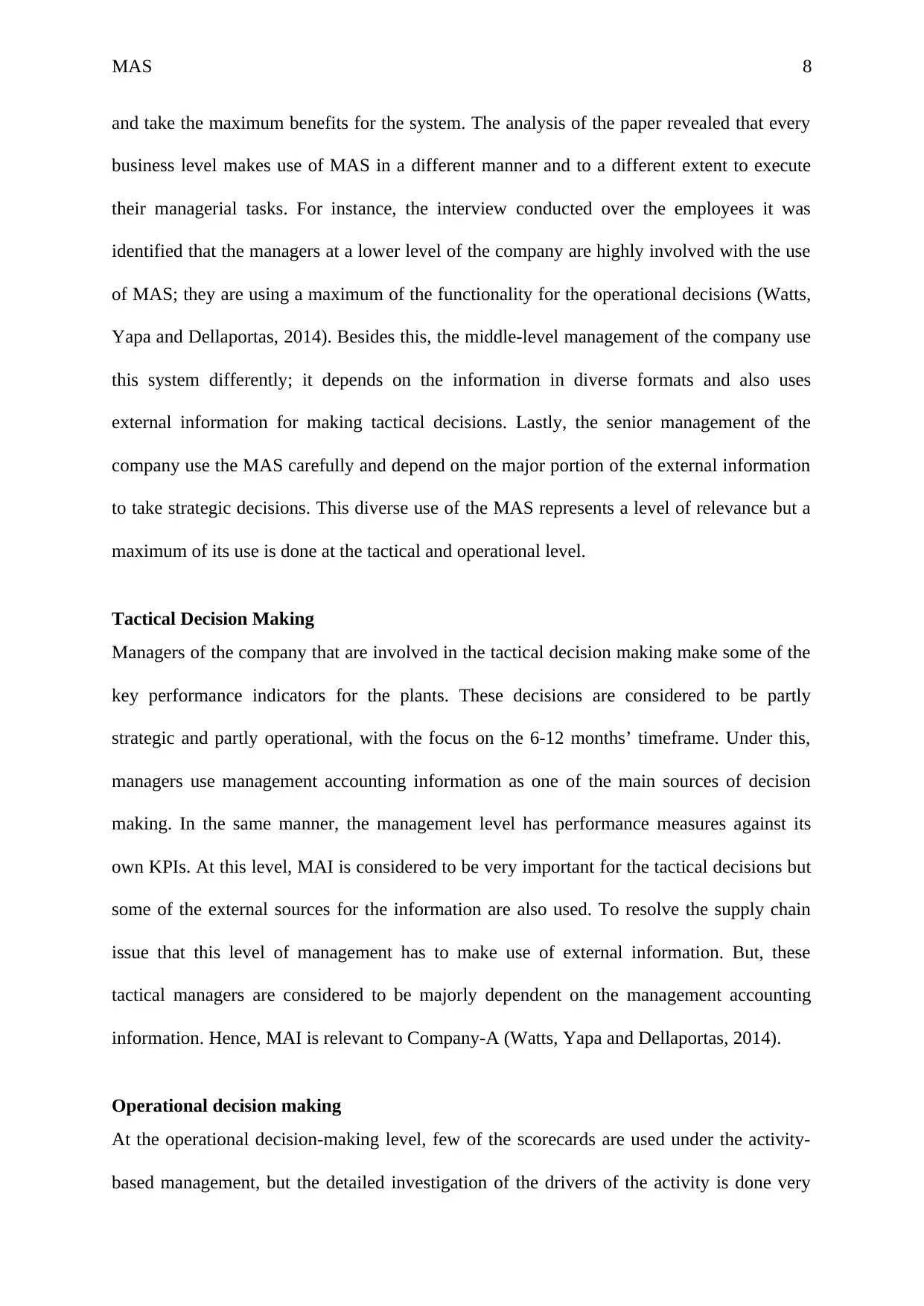
MAS 8
and take the maximum benefits for the system. The analysis of the paper revealed that every
business level makes use of MAS in a different manner and to a different extent to execute
their managerial tasks. For instance, the interview conducted over the employees it was
identified that the managers at a lower level of the company are highly involved with the use
of MAS; they are using a maximum of the functionality for the operational decisions (Watts,
Yapa and Dellaportas, 2014). Besides this, the middle-level management of the company use
this system differently; it depends on the information in diverse formats and also uses
external information for making tactical decisions. Lastly, the senior management of the
company use the MAS carefully and depend on the major portion of the external information
to take strategic decisions. This diverse use of the MAS represents a level of relevance but a
maximum of its use is done at the tactical and operational level.
Tactical Decision Making
Managers of the company that are involved in the tactical decision making make some of the
key performance indicators for the plants. These decisions are considered to be partly
strategic and partly operational, with the focus on the 6-12 months’ timeframe. Under this,
managers use management accounting information as one of the main sources of decision
making. In the same manner, the management level has performance measures against its
own KPIs. At this level, MAI is considered to be very important for the tactical decisions but
some of the external sources for the information are also used. To resolve the supply chain
issue that this level of management has to make use of external information. But, these
tactical managers are considered to be majorly dependent on the management accounting
information. Hence, MAI is relevant to Company-A (Watts, Yapa and Dellaportas, 2014).
Operational decision making
At the operational decision-making level, few of the scorecards are used under the activity-
based management, but the detailed investigation of the drivers of the activity is done very
and take the maximum benefits for the system. The analysis of the paper revealed that every
business level makes use of MAS in a different manner and to a different extent to execute
their managerial tasks. For instance, the interview conducted over the employees it was
identified that the managers at a lower level of the company are highly involved with the use
of MAS; they are using a maximum of the functionality for the operational decisions (Watts,
Yapa and Dellaportas, 2014). Besides this, the middle-level management of the company use
this system differently; it depends on the information in diverse formats and also uses
external information for making tactical decisions. Lastly, the senior management of the
company use the MAS carefully and depend on the major portion of the external information
to take strategic decisions. This diverse use of the MAS represents a level of relevance but a
maximum of its use is done at the tactical and operational level.
Tactical Decision Making
Managers of the company that are involved in the tactical decision making make some of the
key performance indicators for the plants. These decisions are considered to be partly
strategic and partly operational, with the focus on the 6-12 months’ timeframe. Under this,
managers use management accounting information as one of the main sources of decision
making. In the same manner, the management level has performance measures against its
own KPIs. At this level, MAI is considered to be very important for the tactical decisions but
some of the external sources for the information are also used. To resolve the supply chain
issue that this level of management has to make use of external information. But, these
tactical managers are considered to be majorly dependent on the management accounting
information. Hence, MAI is relevant to Company-A (Watts, Yapa and Dellaportas, 2014).
Operational decision making
At the operational decision-making level, few of the scorecards are used under the activity-
based management, but the detailed investigation of the drivers of the activity is done very
⊘ This is a preview!⊘
Do you want full access?
Subscribe today to unlock all pages.

Trusted by 1+ million students worldwide
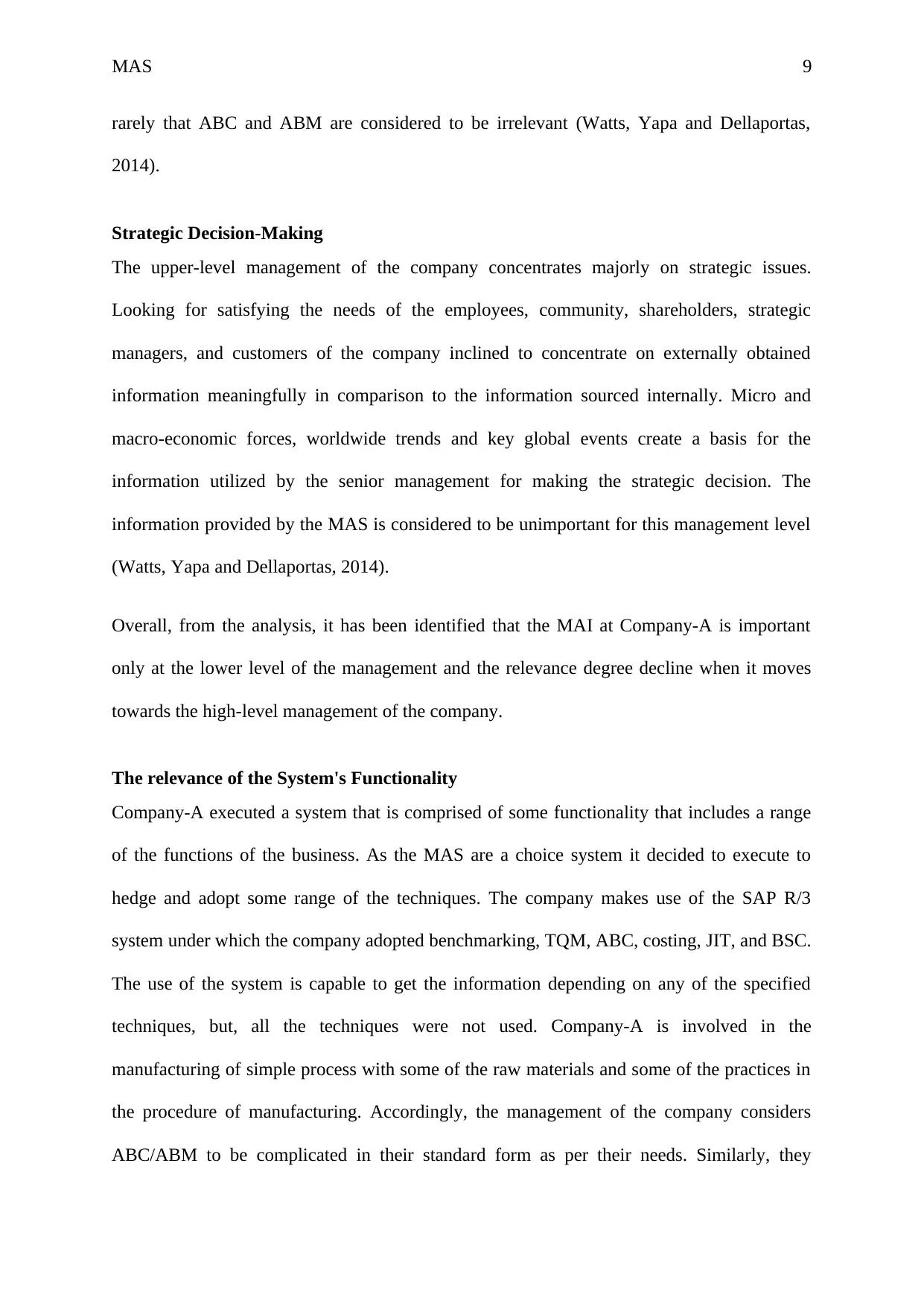
MAS 9
rarely that ABC and ABM are considered to be irrelevant (Watts, Yapa and Dellaportas,
2014).
Strategic Decision-Making
The upper-level management of the company concentrates majorly on strategic issues.
Looking for satisfying the needs of the employees, community, shareholders, strategic
managers, and customers of the company inclined to concentrate on externally obtained
information meaningfully in comparison to the information sourced internally. Micro and
macro-economic forces, worldwide trends and key global events create a basis for the
information utilized by the senior management for making the strategic decision. The
information provided by the MAS is considered to be unimportant for this management level
(Watts, Yapa and Dellaportas, 2014).
Overall, from the analysis, it has been identified that the MAI at Company-A is important
only at the lower level of the management and the relevance degree decline when it moves
towards the high-level management of the company.
The relevance of the System's Functionality
Company-A executed a system that is comprised of some functionality that includes a range
of the functions of the business. As the MAS are a choice system it decided to execute to
hedge and adopt some range of the techniques. The company makes use of the SAP R/3
system under which the company adopted benchmarking, TQM, ABC, costing, JIT, and BSC.
The use of the system is capable to get the information depending on any of the specified
techniques, but, all the techniques were not used. Company-A is involved in the
manufacturing of simple process with some of the raw materials and some of the practices in
the procedure of manufacturing. Accordingly, the management of the company considers
ABC/ABM to be complicated in their standard form as per their needs. Similarly, they
rarely that ABC and ABM are considered to be irrelevant (Watts, Yapa and Dellaportas,
2014).
Strategic Decision-Making
The upper-level management of the company concentrates majorly on strategic issues.
Looking for satisfying the needs of the employees, community, shareholders, strategic
managers, and customers of the company inclined to concentrate on externally obtained
information meaningfully in comparison to the information sourced internally. Micro and
macro-economic forces, worldwide trends and key global events create a basis for the
information utilized by the senior management for making the strategic decision. The
information provided by the MAS is considered to be unimportant for this management level
(Watts, Yapa and Dellaportas, 2014).
Overall, from the analysis, it has been identified that the MAI at Company-A is important
only at the lower level of the management and the relevance degree decline when it moves
towards the high-level management of the company.
The relevance of the System's Functionality
Company-A executed a system that is comprised of some functionality that includes a range
of the functions of the business. As the MAS are a choice system it decided to execute to
hedge and adopt some range of the techniques. The company makes use of the SAP R/3
system under which the company adopted benchmarking, TQM, ABC, costing, JIT, and BSC.
The use of the system is capable to get the information depending on any of the specified
techniques, but, all the techniques were not used. Company-A is involved in the
manufacturing of simple process with some of the raw materials and some of the practices in
the procedure of manufacturing. Accordingly, the management of the company considers
ABC/ABM to be complicated in their standard form as per their needs. Similarly, they
Paraphrase This Document
Need a fresh take? Get an instant paraphrase of this document with our AI Paraphraser
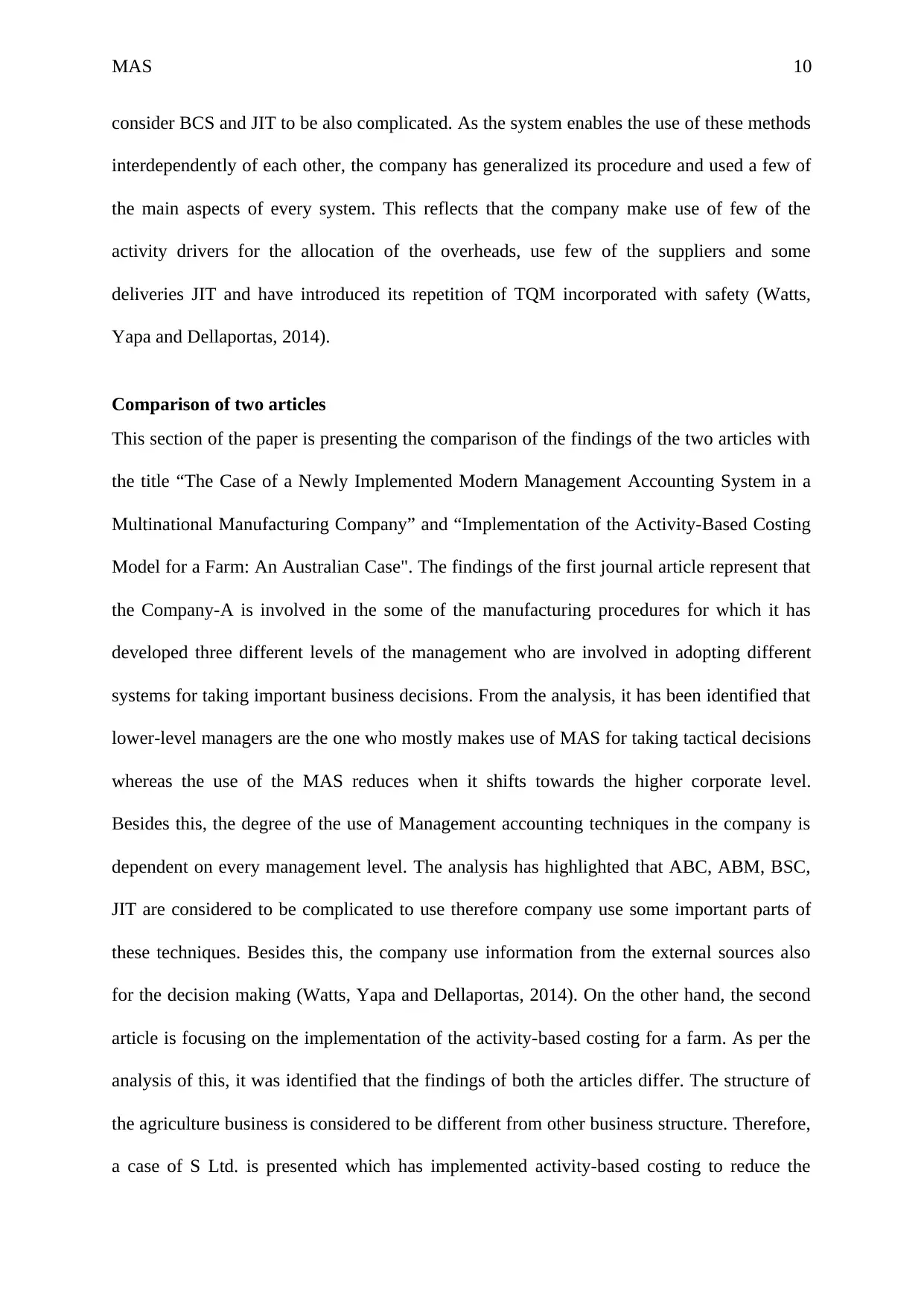
MAS 10
consider BCS and JIT to be also complicated. As the system enables the use of these methods
interdependently of each other, the company has generalized its procedure and used a few of
the main aspects of every system. This reflects that the company make use of few of the
activity drivers for the allocation of the overheads, use few of the suppliers and some
deliveries JIT and have introduced its repetition of TQM incorporated with safety (Watts,
Yapa and Dellaportas, 2014).
Comparison of two articles
This section of the paper is presenting the comparison of the findings of the two articles with
the title “The Case of a Newly Implemented Modern Management Accounting System in a
Multinational Manufacturing Company” and “Implementation of the Activity-Based Costing
Model for a Farm: An Australian Case". The findings of the first journal article represent that
the Company-A is involved in the some of the manufacturing procedures for which it has
developed three different levels of the management who are involved in adopting different
systems for taking important business decisions. From the analysis, it has been identified that
lower-level managers are the one who mostly makes use of MAS for taking tactical decisions
whereas the use of the MAS reduces when it shifts towards the higher corporate level.
Besides this, the degree of the use of Management accounting techniques in the company is
dependent on every management level. The analysis has highlighted that ABC, ABM, BSC,
JIT are considered to be complicated to use therefore company use some important parts of
these techniques. Besides this, the company use information from the external sources also
for the decision making (Watts, Yapa and Dellaportas, 2014). On the other hand, the second
article is focusing on the implementation of the activity-based costing for a farm. As per the
analysis of this, it was identified that the findings of both the articles differ. The structure of
the agriculture business is considered to be different from other business structure. Therefore,
a case of S Ltd. is presented which has implemented activity-based costing to reduce the
consider BCS and JIT to be also complicated. As the system enables the use of these methods
interdependently of each other, the company has generalized its procedure and used a few of
the main aspects of every system. This reflects that the company make use of few of the
activity drivers for the allocation of the overheads, use few of the suppliers and some
deliveries JIT and have introduced its repetition of TQM incorporated with safety (Watts,
Yapa and Dellaportas, 2014).
Comparison of two articles
This section of the paper is presenting the comparison of the findings of the two articles with
the title “The Case of a Newly Implemented Modern Management Accounting System in a
Multinational Manufacturing Company” and “Implementation of the Activity-Based Costing
Model for a Farm: An Australian Case". The findings of the first journal article represent that
the Company-A is involved in the some of the manufacturing procedures for which it has
developed three different levels of the management who are involved in adopting different
systems for taking important business decisions. From the analysis, it has been identified that
lower-level managers are the one who mostly makes use of MAS for taking tactical decisions
whereas the use of the MAS reduces when it shifts towards the higher corporate level.
Besides this, the degree of the use of Management accounting techniques in the company is
dependent on every management level. The analysis has highlighted that ABC, ABM, BSC,
JIT are considered to be complicated to use therefore company use some important parts of
these techniques. Besides this, the company use information from the external sources also
for the decision making (Watts, Yapa and Dellaportas, 2014). On the other hand, the second
article is focusing on the implementation of the activity-based costing for a farm. As per the
analysis of this, it was identified that the findings of both the articles differ. The structure of
the agriculture business is considered to be different from other business structure. Therefore,
a case of S Ltd. is presented which has implemented activity-based costing to reduce the
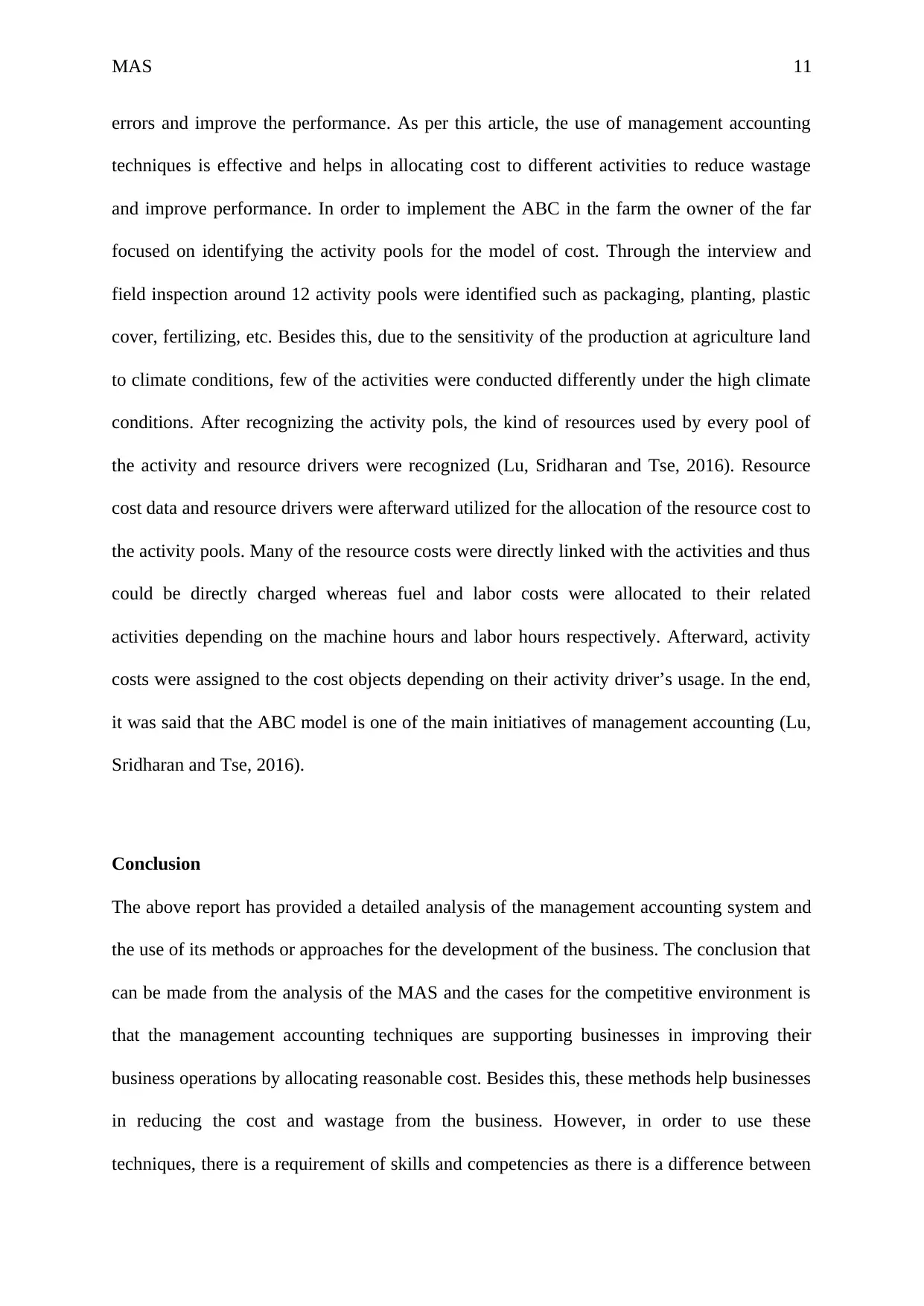
MAS 11
errors and improve the performance. As per this article, the use of management accounting
techniques is effective and helps in allocating cost to different activities to reduce wastage
and improve performance. In order to implement the ABC in the farm the owner of the far
focused on identifying the activity pools for the model of cost. Through the interview and
field inspection around 12 activity pools were identified such as packaging, planting, plastic
cover, fertilizing, etc. Besides this, due to the sensitivity of the production at agriculture land
to climate conditions, few of the activities were conducted differently under the high climate
conditions. After recognizing the activity pols, the kind of resources used by every pool of
the activity and resource drivers were recognized (Lu, Sridharan and Tse, 2016). Resource
cost data and resource drivers were afterward utilized for the allocation of the resource cost to
the activity pools. Many of the resource costs were directly linked with the activities and thus
could be directly charged whereas fuel and labor costs were allocated to their related
activities depending on the machine hours and labor hours respectively. Afterward, activity
costs were assigned to the cost objects depending on their activity driver’s usage. In the end,
it was said that the ABC model is one of the main initiatives of management accounting (Lu,
Sridharan and Tse, 2016).
Conclusion
The above report has provided a detailed analysis of the management accounting system and
the use of its methods or approaches for the development of the business. The conclusion that
can be made from the analysis of the MAS and the cases for the competitive environment is
that the management accounting techniques are supporting businesses in improving their
business operations by allocating reasonable cost. Besides this, these methods help businesses
in reducing the cost and wastage from the business. However, in order to use these
techniques, there is a requirement of skills and competencies as there is a difference between
errors and improve the performance. As per this article, the use of management accounting
techniques is effective and helps in allocating cost to different activities to reduce wastage
and improve performance. In order to implement the ABC in the farm the owner of the far
focused on identifying the activity pools for the model of cost. Through the interview and
field inspection around 12 activity pools were identified such as packaging, planting, plastic
cover, fertilizing, etc. Besides this, due to the sensitivity of the production at agriculture land
to climate conditions, few of the activities were conducted differently under the high climate
conditions. After recognizing the activity pols, the kind of resources used by every pool of
the activity and resource drivers were recognized (Lu, Sridharan and Tse, 2016). Resource
cost data and resource drivers were afterward utilized for the allocation of the resource cost to
the activity pools. Many of the resource costs were directly linked with the activities and thus
could be directly charged whereas fuel and labor costs were allocated to their related
activities depending on the machine hours and labor hours respectively. Afterward, activity
costs were assigned to the cost objects depending on their activity driver’s usage. In the end,
it was said that the ABC model is one of the main initiatives of management accounting (Lu,
Sridharan and Tse, 2016).
Conclusion
The above report has provided a detailed analysis of the management accounting system and
the use of its methods or approaches for the development of the business. The conclusion that
can be made from the analysis of the MAS and the cases for the competitive environment is
that the management accounting techniques are supporting businesses in improving their
business operations by allocating reasonable cost. Besides this, these methods help businesses
in reducing the cost and wastage from the business. However, in order to use these
techniques, there is a requirement of skills and competencies as there is a difference between
⊘ This is a preview!⊘
Do you want full access?
Subscribe today to unlock all pages.

Trusted by 1+ million students worldwide
1 out of 17
Related Documents
Your All-in-One AI-Powered Toolkit for Academic Success.
+13062052269
info@desklib.com
Available 24*7 on WhatsApp / Email
![[object Object]](/_next/static/media/star-bottom.7253800d.svg)
Unlock your academic potential
Copyright © 2020–2025 A2Z Services. All Rights Reserved. Developed and managed by ZUCOL.





